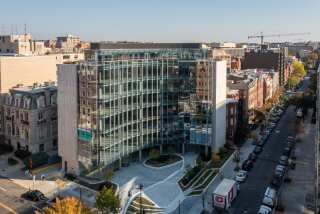Scholars Nurture Einstein’s Legacy at Institute
- Share via
PRINCETON, N.J. — In 1931, Albert Einstein became the Institute for Advanced Study’s first professor. He came to this small New Jersey town, home of Princeton University, to continue his work in theoretical physics at the institute and remained here until his death in 1955.
It was Abraham Flexner, the institute’s first director, who, during a visit to the Einstein’s summer home near Berlin, persuaded the physicist to come to America. Einstein finally responded: “Ich bin Feuer und Flamme dafur!” (“I am fire and flame for it!”)
When French physicist Paul Langevin heard Einstein had accepted Flexner’s offer, he remarked: “It’s as important an event as would be the transfer of the Vatican from Rome to America. The pope of physics has moved and the United States will now become the center of the natural sciences.”
Since then, the Institute for Advanced Study has become the mecca for many of the world’s most promising and distinguished scientists who spend a year at the institute, thinking, researching, writing papers and interacting with others of their caliber. Each of the 200 scholars receives a salary commensurate with his or her current earnings and housing is provided.
Scholars From All Over World
A small nucleus of scholars remains for several years, as Einstein did, becoming part of the permanent faculty of 22.
“Scholars come here from the great centers of learning throughout the world. Most Nobel Prize winners have been here,” said Harry Woolf, 63, who has been institute director for the past 10 years. Woolf is one of the authors and editor of “Some Strangeness in the Proportion,” a book about Einstein’s accomplishments.
“The institute operates on the premise that science and learning transcend national boundaries,” Woolf said. “Scholars and scientists are members of one republic of the spirit. Here they examine new and centrally important questions as they arise at the frontiers of knowledge.”
There is no formal curriculum and no degrees are awarded.
“Nothing is required,” Woolf said. “They have a year of freedom to explore ideas, to interact with one another in an atmosphere where the mind is working at the highest level. We have no scientific laboratories. Their work is not published here. Our contribution to society is like yeast. The bread gets baked elsewhere.”
Near Princeton Campus
Scattered throughout the world in practically every major university are 3,300 alumni of the stimulating intellectual community.
The Institute for Advanced Study occupies a square mile embraced by forests and meadows. It is near the Princeton campus, enjoying a close academic and intellectual relationship even though it is administratively separate.
Included in the institute complex are 10 buildings, mainly studies, libraries, administrative and faculty offices, common rooms, computer centers, a lounge, a dining hall where luncheons and twice-weekly dinners are served and garden apartments.
The apartments are assigned by family size. All faculty members receive the same pay regardless of age or years of tenure.
“We have a marvelous egalitarian system here,” observed Woolf, the fifth director. Flexner served until 1939; Frank Aydelotte, 1939-47; J. Robert Oppenheimer, 1947-66, and Carl Kaysen, 1966-75.
Studies Always Open
Libraries and studies are available around the clock. Many of the scholars do their best work in the middle of the night.
The current institute budget is $13 million, with 65% coming from its endowment and the rest from visiting scholars’ own institutions, from private foundations, the U.S. government and foreign governments. About one-fourth of the scholars come from other countries.
There are four schools at the Institute for Advanced Study: mathematics, natural sciences, historic studies and social science.
There is a balance of senior scholars with well-established reputations and younger scholars four or five years after earning their Ph.D.’s.
It was a brother and sister, Louis Bamberger and Caroline Bamberger Fuld, who established the Institute for Advanced Study “to repay America for our success.”
They Found Flexner
They owned the Bamberger department store chain that they sold in 1929 just before the crash. Childless, they decided to establish a university with their fortune.
“They looked around for someone to guide them and they found Abraham Flexner, a leading educator, who told them ‘The world does not need another university,’ ” Woolf said.
It was Flexner who initiated formation of the institute and became its first director.
The founders insisted there never be any discrimination by race, religion or sex in the appointments to the faculty and staff or selection of visiting scholars.
“It is a great honor to be here. This is the best place for pure math in the whole world. We follow in the footsteps of Albert Einstein and many of the top scientists of the last 53 years,” said Dragan Milicic, 37, of Yugoslavia, a math professor at the University of Utah before coming here.
‘Very Exciting Place’
Milicic and Siddhartha Sahi, 27, of Allahabad, India, who received his Ph.D. at Yale, are spending their year in a special program dedicated to the representation theory of math.
“In a sense representation math is a fairly new subject, like most math, a culmination of a lot of different theory,” Milicic explained. “This is a very exciting place. It affords me the luxury of a lot of time to think about representation theory. Time is something I did not have an abundance of while teaching.”
Homer A. Thompson, 79, an archeologist, is the senior faculty member. He is the foremost authority on the excavation of the Athens Civic Center that thrived from the 6th Century BC to the 3rd Century AD.
Thompson began his work in Athens in 1929 and is still at it, spending upwards of six months each year in the Greek city. He has been a faculty member at the institute since 1947 and has written books on classical archeology.
Einstein was an “an extremely kindly and helpful colleague,” Thompson said. He recalled the last time he saw Einstein, in 1955: “I had a young visitor from India who wanted to meet Einstein. I called the old man and he said come on over. The young Indian had a theory of how India might come to terms with its neighboring nations, a theory Einstein was skeptical about.
“The young Indian asked if Einstein would step outside so he could pose with him for a picture. He had a camera but no flash unit. Einstein was wearing a pullover sweater, shirt, pants and shoes with no socks. He stepped outside in that cold, blustery day and I photographed the old man and the young Indian. He didn’t believe in the young man’s theory, but he braved the cold anyway, so he wouldn’t disappoint him.”
Another Einstein Story
Woolf also had an Einstein story to tell, as does most everyone at the institute. Woolf said Einstein was returning to Princeton from New York on a train when a man sitting next to him said: “You look familiar. What do you do?”
Einstein, who had one of the most famous faces in human history, replied: “I’m an artist’s model.”
Thirty years ago, J. Robert Oppenheimer had this to say about the Institute for Advanced Study:
“The immediate effects of the institute’s work are in knowledge and in men. The new knowledge and the ideas find their way into the worldwide communities of science and scholarship, and the men take their part throughout the world in study, in teaching, in writing and in discovering new truth.
“History teaches--and even the brief history of the institute confirms--that new knowledge leads to new power and new wisdom, and alters the destiny and heightens the dignity of man.”
More to Read
Sign up for Essential California
The most important California stories and recommendations in your inbox every morning.
You may occasionally receive promotional content from the Los Angeles Times.










